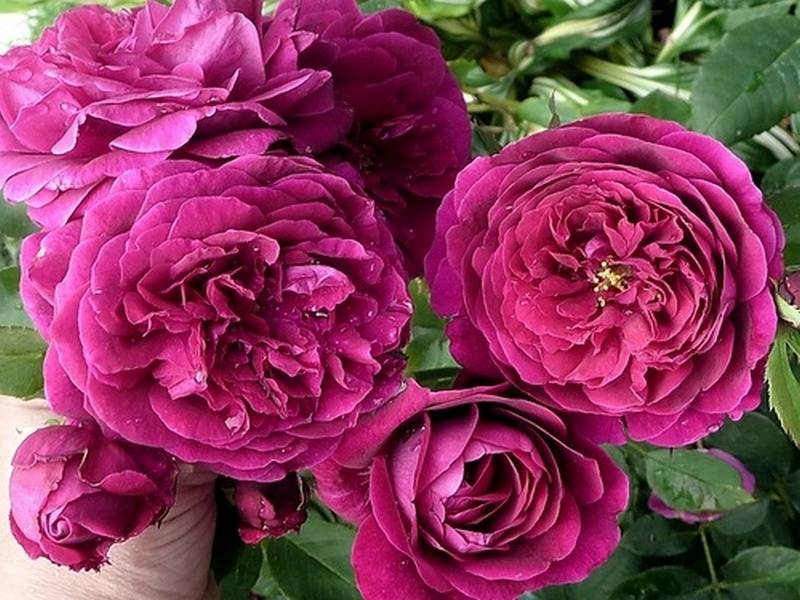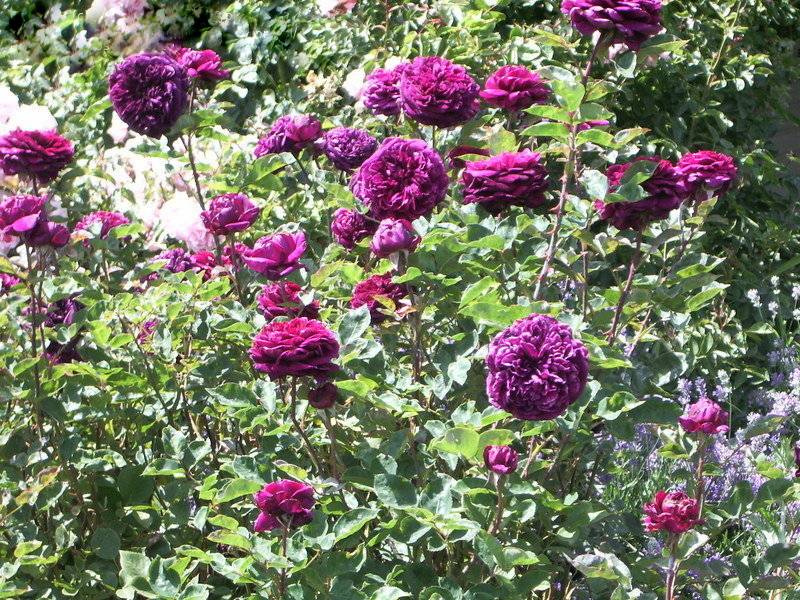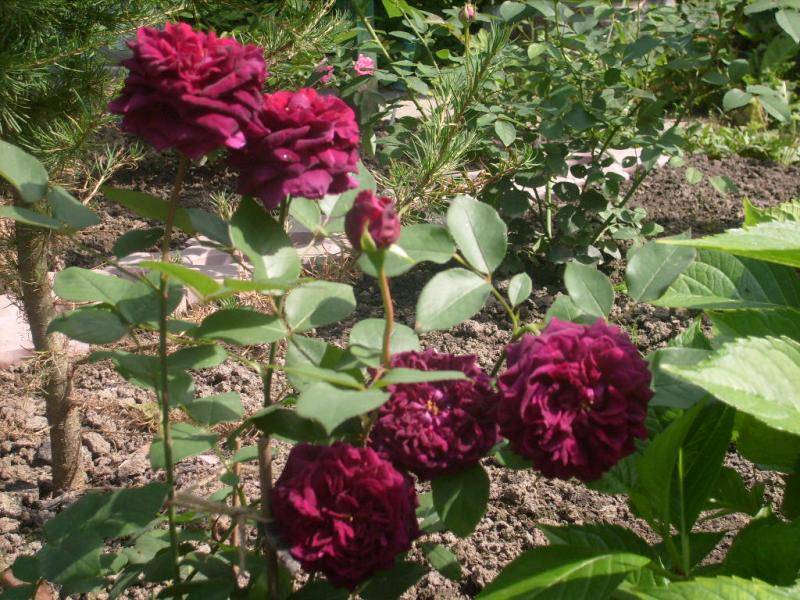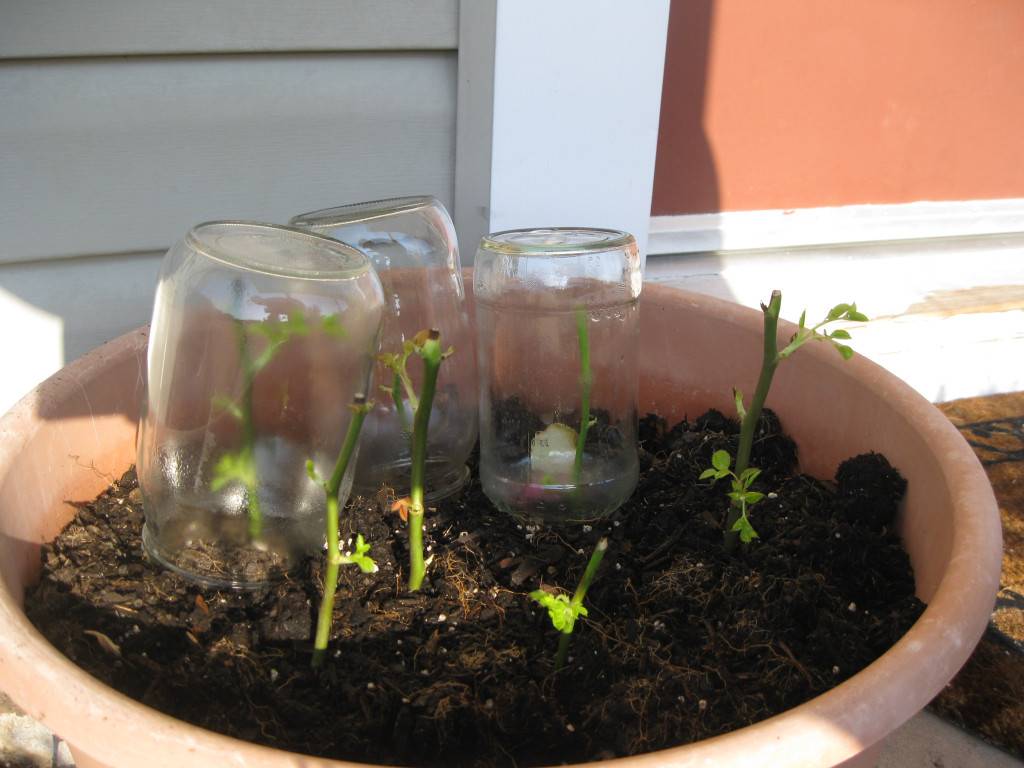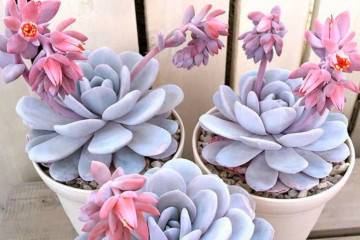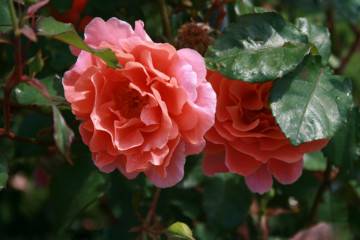Rose Prince
Content:
The English park rose Prince is an authentic and unsurpassed classic. The unique shade, which breeders have not been able to replicate until now, cannot but attract enthusiastic attention.
Rose Prince (The Prince) - what is this variety
The variety was obtained in England in 1840. It was created specifically for cultivation in parks without shelter, as well as in greenhouses for cutting. By Graham Thomas. The unique shade of the petals is close to the Gallic roses (Rose Gallica) and is not found in modern hybrids.
The park-bush rose Prince is formed by a low bush - up to 75 cm in height, rather small by today's standards. Shoots are straight and brittle, covered with thorns. The leaf is large, dark green, with a slight gloss. The flower consists of more than a hundred petals of a complex velvety raspberry-purple-purple hue. As the final opening progresses, a large (up to 8 cm in diameter) cup-shaped flower bends the petals back. 3-5 buds are formed on each stem.
Flowering - renewable with a long intermediate interval (up to 2.5 months).
Advantages and disadvantages of the variety
Valuable advantages of this rose:
- A strong and long-lasting classic pink scent.
- Unique shade of petals.
- Suitable for growing outdoors and in a greenhouse.
- Frost resistance - up to -23 ° С.
- Not prone to shedding of petals.
- Reproduces well by cuttings.
There are quite a few shortcomings, which indicates more on the exactingness of the shrub to care:
- It does not tolerate strong wind, which breaks branches and even buds. Plant in a protected area.
- Rose English Prince does not tolerate rain on the buds, whose appearance deteriorates very quickly because of this.
- Prefers partial shade, in the hot sun the flowers burn and dry out.
- Medium resistance to powdery mildew and black spot.
Rose Prince should be planted in the shade of large trees, not in the foreground of mixborders. Flowers of amazing beauty are very delicate and cannot stand rain, direct sun, strong wind. If you want to get beautiful shoots for cutting, it is recommended to plant a bush in a greenhouse or greenhouse.
Growing a rose bush
For the successful cultivation of the variety, it is necessary to be very careful about the choice of a place for planting and subsequent care.
The park rose Prince is found in specialized nurseries, where a very large assortment is presented. Despite the fact that the Prince was bred for a long time, today his unique color is overshadowed by the newest hybrids. Saplings are sold in two types: regular and on a rosehip rootstock (to increase frost resistance).
What time is the boarding
With the onset of the third decade of April, it is worth starting to search for a prince rose seedling. If you are lucky, you can land it immediately, otherwise you will have to wait until mid-September.
Location selection
The best place for this rose is under tall trees or shrubs.They will be able to protect the Prince from the wind and hot sun, and in the rain they will cover from the gushing streams.
How to prepare the soil and flower for planting
If the planting is carried out in the spring, then the site is prepared in the fall, digging up the soil and mixing with a large amount of humus or humus. The same is done during the autumn planting, preparing the bed in a month.
Rosa Prince prefers slightly acidic soil with a pH of 5.5-6.5. Black soil is perfect, and more loosening components must be added to the loam: peat, river sand, sawdust (for autumn digging).
Seedlings with closed roots in shipping containers do not need to be prepared in any way - they are ready for immediate planting throughout the summer. Bushes with an open root system are soaked for 6 hours in a solution of a root stimulator. When planting in autumn, be sure to shorten all the shoots along with the buds, leaving only 20 cm.
Planting procedure step by step
This work is performed according to the standard scheme:
- Dig a planting hole 50 cm deep, and the same amount retreating from neighboring plants.
- At the bottom, a layer of 5-7 cm is poured from crushed stone of the finest fraction or expanded clay for drainage.
- For backfill, a fertile loose soil is prepared, to which humus and 50 g of superphosphate are added.
- The roots are lowered into the hole, deepening the neck by 3-5 cm.
- Sprinkle with soil and watered immediately.
- Mulch with needles, sawdust, peat, sphagnum - what is available.
Plant care
From how carefully the gardener approaches the issue of care, it directly depends on whether this year it will be possible to see the extraordinary beauty of the Prince.
Watering rules and humidity
Watering is carried out throughout the warm season. As soon as the soil dries out 5 cm deep, it is necessary to pour 10 liters of water under each bush. Sprinkling is not recommended during flowering, but in between during the hottest months in the early morning or after sunset.
Top dressing and soil quality
In total, up to 7 dressings are carried out per season:
- The first consists of ammonium nitrate in the amount of 20 g per 1 m².
- The subsequent ones alternate: organic (mullein solutions, humate) and mineral (potassium and phosphorus in a ratio of 3: 1 in an amount of up to 30 g per 1 m²).
Pruning and replanting
Shoots are cut in spring, summer and autumn. Their goal is to form a strong and symmetrical shrub with lots of young shoots.
Once every 3 years, they practice rejuvenation, when the shoots are shortened in spring, leaving no more than 3-4 buds on each. In the first year, all buds are removed to build skeletal branches. Autumn pruning prepares the bush for wintering, therefore, remove all unripe branches and buds.
The prince is a rose that does not like transplants. The procedure is carried out only in case of emergency: in the spring before bud break, or in the fall in the first half of September.
Features of wintering a flower
For the winter, in regions where the winter air temperature drops at least -10 ° C, you can do without shelters. In the zone of winter minimums up to -23 ° C, the bush is hilled with a thick layer of peat, on top of which spruce branches are laid.
Blooming rose prince
Flowers are exactly what gardeners care for the Prince so carefully. He needs to be paid maximum attention during the entire active growing season.
- The first wave of flowering occurs in the first half of June. The bush expels a maximum of buds, which stay on it for about 2 weeks.
- This is followed by a long break: 2-2.5 months.
- Therefore, the second wave of flowering begins (usually mid-September).
Alas, in many regions it is not possible to see the second wave due to climatic conditions.
During the entire time of blooming, it is necessary to create truly greenhouse conditions for the bush: cover it from rain and sun, feed it regularly, and immediately remove wilted buds.
What to do if it does not bloom, possible reasons
Reasons for the lack of flowers:
- Lack of nutrients in the soil: urgent feeding is needed. The sign is sluggish and skinny shoots.
- Incorrect pruning, the bush has grown out, suffocating itself with extra weak shoots.
- Lack of lighting. The rose feels good in partial shade, but 4 hours a day (preferably in the morning) she needs sunlight.
- The foliage is affected by a fungal disease or damaged by pests, treatment with fungicides and insecticides is necessary.
Flower propagation
With the help of green strong shoots, cuttings can be carried out. The Prince shrub rose does not propagate by seeds, since it is possible to wait for flowers from such a plant only 3-4 years later with success.
The beginning of June and the second half of September are suitable for cutting planting material.
Detailed description
In autumn, during pruning, healthy lignified shoots with a length of more than 10 cm are selected. They are placed in a box with sand, where they have to lie at temperatures from 0 to + 4 ° C until spring. The sand is periodically slightly moistened as it dries. In the spring in mid-May, cuttings are buried in the open ground and covered with a greenhouse.
In the first half of June, green cuttings are harvested. The tops of the shoots are cut, removing the bud to the first bud. The optimal cutting length is 10-12 cm with 3 pairs of buds. The lower leaves are removed, and the upper ones are shortened by half. Then the finished cuttings are planted in the same way in a prepared place, covered with a greenhouse. At the end of August, they are dug up and transplanted into pots, which are kept cool (about 0 ° C) until next spring.
Diseases, pests and ways to control them
The greatest damage to the plant can be caused by:
- Powdery mildew. All affected parts are cut out and burned, and the rose is treated with an ash solution infused for 5 days (1 glass per 10 liters of water).
- Black spot. Spring treatment with Fitosporin will help in 2 stages: first with a solution of 7 ml per 1 liter of water, and after a week - 3.5 ml per 1 liter of water.
- Rust. To prevent already affected bushes, they are sprayed with a solution of Bordeaux liquid in 2-3 doses with an interval of 7-10 days.
- Aphid. Sprayed with Spark, Bison, Commander.
- Leaf roll. The preparation Lightning helps.
- Spider mite. Spray with Iskra-M solution in two approaches with an interval of 10-12 days.
Raising a Prince in a garden is an activity for true connoisseurs who are keen on obtaining rare and unusually beautiful flowers. A rich lilac-purple hue and a fabulous scent are the most famous characteristics of this English rose.
